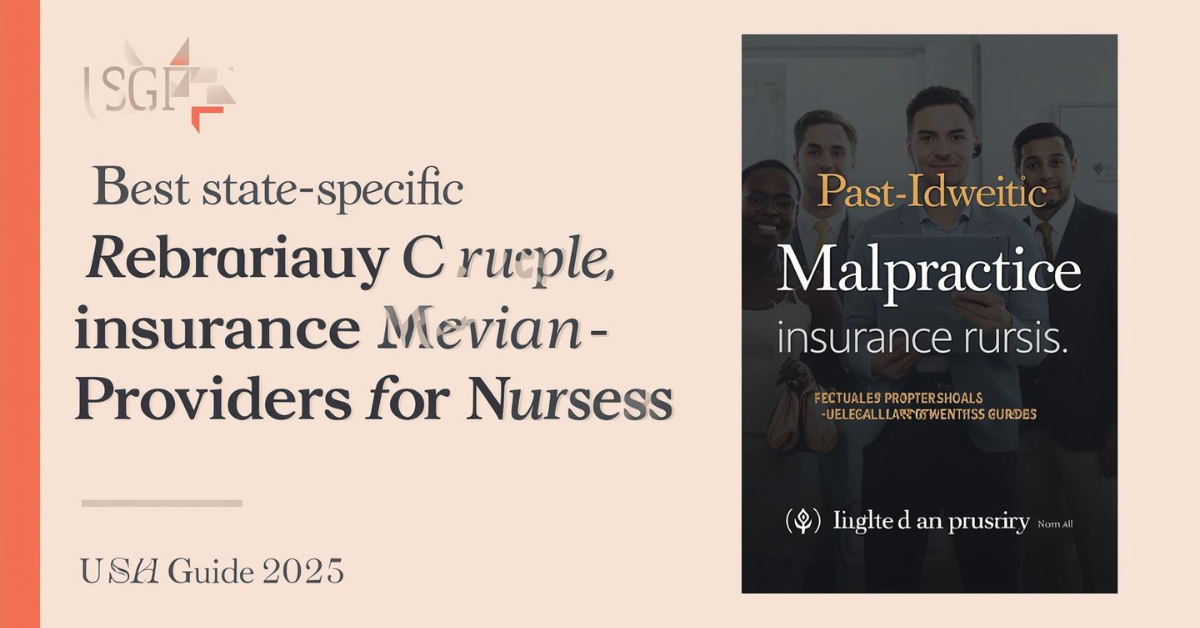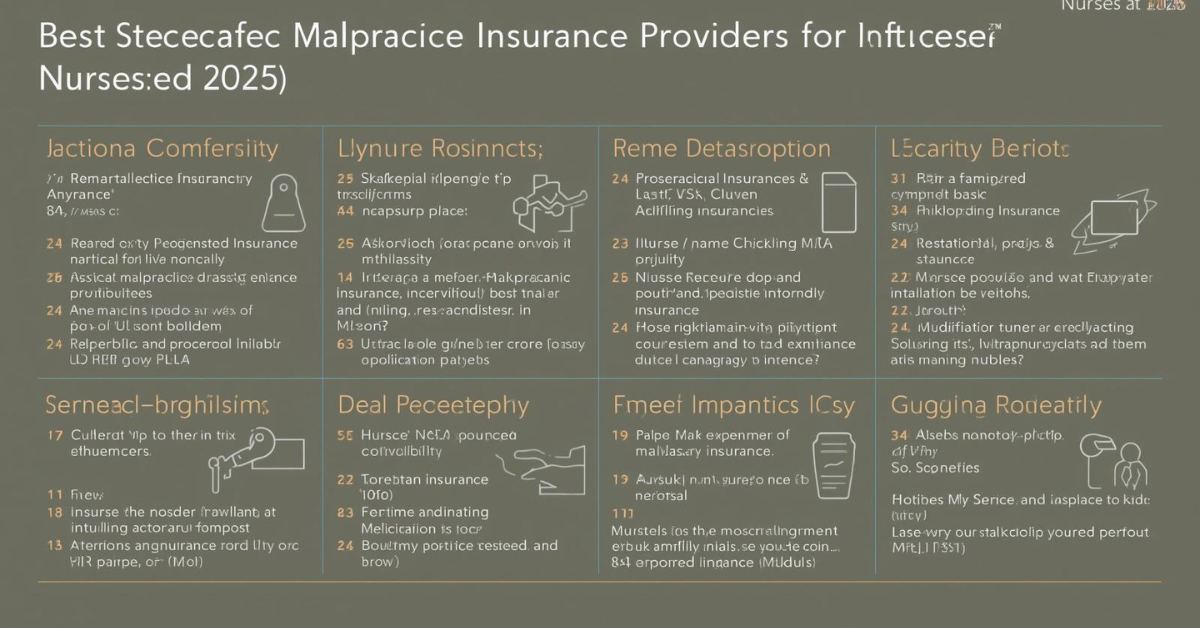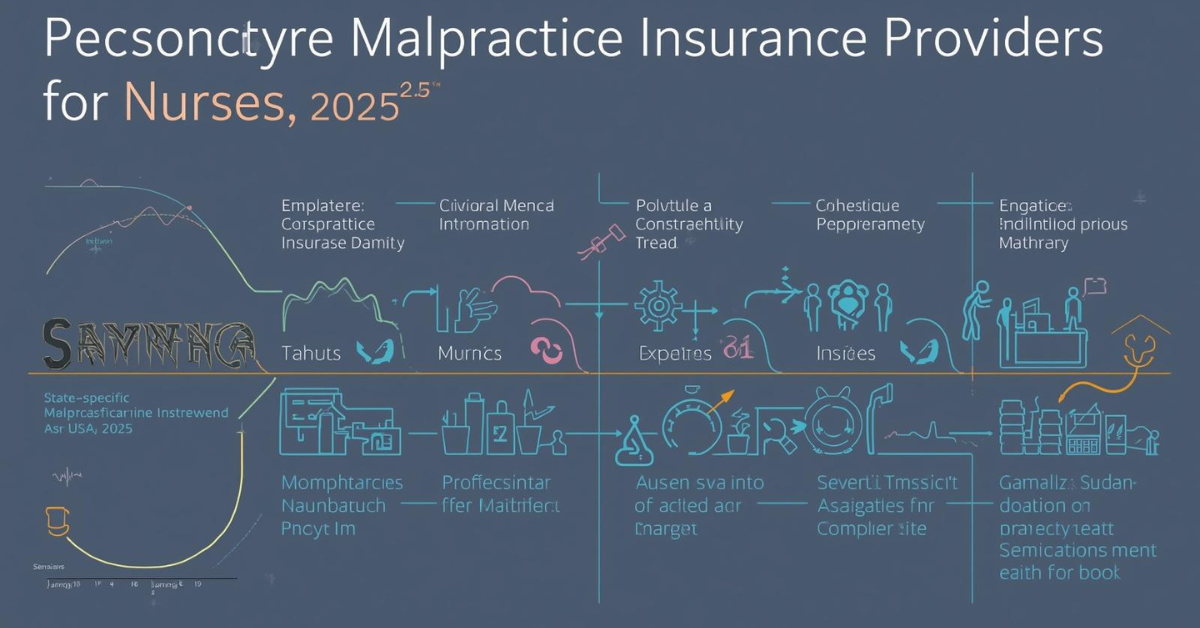Best State-Specific Malpractice Insurance Providers for Nurses (USA Guide 2025). Several major professional liability insurers for healthcare workers, such as NSO, HPSO, and Berxi, offer customized plans that are tailored to the specific legal and professional needs of healthcare workers in some U.S. states. While these insurers operate nationwide, your state of residence is a crucial factor in determining the scope, terms, and cost of your coverage.
State-Specific Malpractice Insurance Best Providers for Nurses (USA Guide 2025)
Picture you are a committed RN in California, sure of your clinical skills, when suddenly a patient brings a lawsuit claiming negligence during a basic IV injection. Without sufficient malpractice insurance, you could lose your nursing license and face terrible legal expenditures exceeding $50,000. The reality every nurse has to grasp is that state laws vary greatly across the United States and your employer’s coverage usually won’t protect you in personal lawsuits. Choosing the correct malpractice insurance provider is not only for newly licensed graduate beginning your first shift or a travel nurse is traversing state lines. Smart—essential defense for your career, your money, and your peace of mind in the difficult healthcare scene of 2025.
Rapid Shot: State-Specific Essential Malpractice Insurance
- Average yearly premium: $100–300 for comprehensive coverage with $1M/$6M limitations
- Coverage begins usually within 24 hours of authorization.
- State requirements range by region; some states demand coverage for particular practice contexts.
- Maximum coverage: $1 million per event, recommended total of $6 million
- Most policies move with you throughout state lines for short-term work.
- Typically tax-deductible as a business expense, premiums are tax-advantaged.
- Knowing claims-made versus occurrence will help you to survive state changes and might help you to save your career.
What is State-Specific Malpractice Insurance for Nurses?
Designed to shield nurses from the financial and legal ramifications of malpractice claims brought against them personally, state-specific malpractice insurance, also called as professional liability insurance, is specialist coverage. View it as your own safety net in the event of patient treatment complications. Unlike the coverage your hospital or clinic provides, which mostly safeguards the building and may not cover your personal assets or license defense, individual malpractice insurance is yours exclusively.
It follows you from job to job, state to state, and even covers you during volunteer work or part-time employment. As nurses in 2025 increasingly operate across several states utilizing compact licenses and telehealth systems, knowing how your policy applies in different jurisdictions has become absolutely essential. The state-specific dimension relates to how providers customize coverage limitations, premium charges, and policy conditions depending on the litigation environment, state board rules, and legal standards where you operate.
Why State-Specific Coverage Matters for Your Nursing Career
Depending on your state of residence, the legal terrain for nurses varies significantly. Nurses in high-litigation states like Florida, New York, and Pennsylvania have substantially more chance of being named in lawsuits, which has a direct effect on insurance rates and coverage availability. Your State Board of Nursing wants you to uphold professional standards particular to your area; hence, when problems surface, having insurance that satisfies local laws becomes your best defense.
Think about it: just based on state court statistics and average jury awards, a nurse in Texas may pay $150 year for the same coverage costing a nurse in California $280. Beyond price, certain states like Colorado have specific standards for advanced practice registered nurses to maintain minimum coverage levels; others strongly recommend but don’t require coverage for bedside nurses.
Your insurance status also directly affects your pay and professional development. Many travel nursing firms demand evidence of personal malpractice insurance before appointment, and some Magnet facilities favor employing nurses who show professional accountability via individual policies. State-specific coverage recognizing your enlarged scope becomes non-negotiable if you are pursuing higher credentials, starting a private practice, or acting as a legal nurse consultant.
Most essentially, your malpractice insurance usually pays for lawyer fees, investigation expenses, and hearing fees during license defense hearings before your State Board of Nursing could otherwise deplete your bank account. Without this protection, defending even minor complaints can cost thousands of dollars, possibly derailing your whole professional trajectory.
Comprehensive State-by-State Provider Comparison
National Providers with Strong State Coverage
Offering coverage in all 50 states with premiums beginning at $98, NSO (Nurses Service Organization) serves as the biggest malpractice insurance carrier just for nurses. Between $300 a year depending on your location and expertise. Standard coverage is $1 million per incident and $6 million aggregate, with optional higher limits for advanced practice nurses.
NSO is aware of state-specific rules and automatically changes your coverage if you travel across state borders via compact licensure or travel assignments. Their claims-made policies include free tail coverage when you retire, and they provide license defense coverage up to $25,000 per incident for State Board inquiries.
Beginning at $95 a year, Mercer specializes in covering nurses who work in several states at once. It offers competitive prices. Their occurrence-based policies guarantee long-term defense for occurrences occurring inside your coverage period independent of the claim year later. For nurses switching to various specialties or traveling between states, this becomes especially useful. Recognizing the contemporary dangers nurses encounter outside of conventional malpractice, Proliability also incorporates identity theft protection and personal liability insurance as policy extensions.
With instant internet quotes and coverage activation within hours, Berxi, supported by Berkshire Hathaway, has developed as a serious competitor in 2025. Customized coverage from their state-specific pricing algorithm comes from your exact practice location, specialty, and work settings. Berxi provides claims-made as well as occurrence plans; their yearly premiums normally run from $110 to $265. As nurses provide virtual consultations across state lines and remote patient monitoring grows in importance, they excel in covering telehealth nursing.
High-Risk State Specialists
CM&F Group (Coopersmith, Merucci & Friedman) is an expert in high-risk coverage with great experience supporting nurses in difficult legal situations. Though their premiums start higher at roughly $250 a year, they include dedicated claims specialists aware of state-specific lawsuit patterns as well as enhanced legal defense resources. Working with NSO, Service Organization (HPSO) offers extra cover layers created especially for nurses in states with historically high jury awards.
Multi-state Coverage and Traveling Nurse
American Professional Agency provides special coverage geared especially toward travel nurses and small license holders traveling frequently across state lines. Without your need to buy different policies, their policies automatically adapt to satisfy the minimum standards of each state and the legal climate. Eliminating the complexity of having several policies, yearly premiums range from $180 to $320. Acknowledging the particular situations of temporary missions, Lockton Affinity also offers specialized travel nurse coverage including housing liability and rental vehicle insurance.
Step-by-Step Guide to Choosing Your State-Specific Coverage
Assess Your Current Practice Situation
Start by writing down exactly where and how you practice nursing. List your primary job status, any further states in which you are licensed under compacts, and whether you work part-time, volunteer, or participate in telehealth. Check the website of your State Board of Nursing especially if you are an APRN, CRNA, or nurse practitioner to find out whether your state calls for certain coverage levels. Review your employer’s policy papers to see what their coverage really protects—most hospital policies defend the institution but expressly exclude individual nurse protection, rendering you personally vulnerable in lawsuits.
Assess Your Risk Level and Insurance Needs
Your expertise and patient base will help you to identify the right coverage restrictions. Usually facing more legal risk than school nurses or career health nurses are emergency department nurses, labor and delivery nurses, critical care specialists, and psychiatric nurses. Typical $1 million per event coverage might be inadequate if you are practicing in a high-case state; think about raising caps to $2 million per event and $6 million overall. Based on their insistent ability and independent breadth of practice, advanced practice nurses should evaluate coverage levels between $1 million and $3 million per accident.
Compare Claim-Made Against Occurrence Policies for Your State
Claims-made plans cover incidents that happen and are reported while your policy is still in effect; therefore they are less expensive upfront but need continual coverage or high tail coverage when you switch insurers. Though they cost roughly 30 to 40% more yearly, occurrence policies offer permanent protection for any event during your coverage period, regardless of when someone files the claim. Occurrence policies usually turn out more economical long-term for nurses aiming to have long careers in the same state. Claims-made policies provide inexpensive entry-level coverage while you chart your career course, but they also protect you if you are a new graduate or travel nurse.
Request State-Specific Quotes from Multiple Providers
Visit at least three provider websites and enter your correct practice information to get tailored pricing. NSO, Proliability, and Berxi all provide immediate online estimates without needing phone calls. Pay attention to what each quote includes beyond basic coverage—license defense costs, legal representation quality, crisis management support, and whether premiums remain fixed or increase annually. If you hold compact licensure or plan to work temporary assignments in multiple states, ask especially about multi-state coverage clauses.
Confirm State Board Defense Coverage
Often overlooked, this trait can save your job and thousands of dollars. Make sure your policy specifically covers legal expenses and costs relating to State Board of Nursing inquiries, disciplinary hearings, and license protection procedures. Most board inquiries should be covered by regular coverage levels of $10,000 to $50,000 per occurrence. Some providers such as NSO include this coverage automatically, while others make it available as a supplemental option. Considering that even little board complaints could cost legal expenses ranging from $5,000 to $15,000, this coverage feature needs thorough assessment.
Analyze Payment Choices and Policies Activation
Though yearly payments often save 5 to 10 percent on overall premiums, most providers provide monthly installments or annual payment plans. Verify with your insurer how fast coverage becomes effective after purchase; some providers provide same-day coverage while others demand 24 to 48 hours for clearance. Should you be taking a new job, make sure your insurance kicks in before your first clinical rotation. To prevent coverage gaps that could leave you vulnerable during major career changes, automate renewal with your service.
Expert Tip Box: Nurse Educator’s Insight
Having examined thousands of malpractice cases and counseled nurses across the nation, I have noted a remarkable tendency: nurses who experience the least financial and Emotional loss during legal issues is among those who bought individual coverage before they needed it, not following an event happened. Many nurses falsely assume their employer’s insurance fully covers them only to find out during a lawsuit they require independent legal counsel since their interests opposition to the defensive plan used by the hospital.
My best advice for 2025 is to buy an occurrence-based policy early in your career, even if it runs a little bit more than claims-made coverage. This one choice removes any future concerns about tail coverage, shields you eternally for past events even after you switch jobs or retires, and offers peace of mind that’s literally priceless. Additionally, treat your premium as a non-negotiable professional expense, much like keeping your nursing license or fulfilling CEU requirements. Less than one shift’s pay, the modest yearly cost safeguards your whole career investment and personal possessions from possibly devastating financial effects.
Safeguard Your Future and Your Career
Individual malpractice insurance has changed from discretionary coverage to necessary career protection for every practicing nurse as healthcare grows more complicated and litigious throughout the United States. You deserve complete protection from state-specific coverage that fits your local legal environment, board rules, and lawsuit context.
Whether you are an experienced travel nurse changing between California and Arizona or a recent graduate beginning your first nursing job in Texas, or an advanced practice Nurse setting up a Florida-based private clinic, the right malpractice insurance policy protects your financial affairs, professional reputation, nursing license, and your ability to confidently keep treating patients. Before you become engaged in a board complaint or lawsuit, understand the need of this coverage.
Ask for quotes from NSO, Proliability, and Berxi right now; contrast your state-specific choices; and choose coverage appropriate for your practice reality. This astute investment in professional security will be much appreciated by your future self. Looking for more means to develop your nursing career and preserve your professional reputation? Check out our extensive tutorial on Free CEU Courses for Nurses—instant Certificates downloaded to keep your license requirements while acquiring useful skills.
Frequently Asked Questions About Nurse Malpractice Insurance
Do I really need malpractice insurance if my hospital already has coverage?
Yes, you really need your own policy as hospital insurance mostly shields the facility rather than individual nurses. When legal action results, hospitals and nurses frequently have opposing legal interests: the hospital’s attorney represents the institution’s best interests, not your own. During side jobs, telemedicine consultations, or after you leave that company for past events, your employer’s policy won’t cover you. Furthermore, hospital coverage seldom provides State Board of Nursing defense, therefore you are personally liable for attorney fees during license inquiries that can readily cost $10,000 or more.
For nurses in 2025, how much does state-specific malpractice insurance really cost?
Usually ranging from $98 to $320, annual premiums for comprehensive malpractice insurance with standard $1 million per occurrence and $6 million aggregate coverage depend on your state, expertise, and coverage kind. While nurses in low-litigation jurisdictions like Wyoming, South Dakota, or Vermont might pay as little as $98 a year, those in high-risk states like New York, for comparable coverage, Pennsylvania or Florida usually charges $250 to $320.
Usually paying between $200 and $600 annually for increased coverage restrictions, advanced practice nurses with prescriptive power. Usually tax-deductible as professional expenses, these premiums effectively lower your real cost.
What separates claims-made and occurrence professional liability insurance?
Claims-made policies offer coverage only when both the incident and the claim happen inside your policy’s active period; hence, you have to buy costly tail coverage. You switch or cancel insurance to guard against upcoming claims for prior work. Occurrence policies cover any event happening inside your coverage period independent of when someone files the claim, even years after your policy expires.
Although occurrence policies cost 30 to 40 percent extra yearly, they get rid of tail coverage issues and offer permanent protection for previous work, making them perfect for nurses who are planning long careers. New grads or those in temporary positions benefit from claims-made policies; nevertheless, to avoid gaps, continual coverage or tail insurance is needed.
Does my malpractice insurance cover me when I work as a travel nurse in different states?
Though you should confirm this explicitly while buying your policy, most respectable malpractice insurance companies give coverage that travels with you throughout state lines for temporary positions. Without needing separate policies, providers like NSO, Proliability, and American Professional Agency automatically modify coverage to fit each state’s rules. But you should inform your insurance company if you decide to live permanently in a different state or begin regular practice in many states at once to make sure you have continuing correct coverage. Some rules automatically include this protection for compact license holders while others charge little administrative costs for multi-state coverage changes.
Should the State Board of Nursing investigate me, will malpractice insurance pay legal expenses?
Quality malpractice insurance policies feature license defense coverage especially for State Board of Nursing inquiries, disciplinary hearings, and administrative processes apart from your primary malpractice coverage boundaries. Usually ranging from $10,000 to $50,000 per occurrence, this coverage covers legal fees, investigative expenses, hearing costs, and other legal charges should your license comes under discipline or claims.
This protection is priceless because even modest State Board complaints often produce legal costs of $5,000 to $15,000, and your employer’s insurance certainly won’t cover these. Always check to be sure your policy specifically provides license defense coverage because some budget policies omit this essential safeguard to allow lower premiums.
Read More:
https://nurseseducator.com/didactic-and-dialectic-teaching-rationale-for-team-based-learning/
https://nurseseducator.com/high-fidelity-simulation-use-in-nursing-education/
First NCLEX Exam Center In Pakistan From Lahore (Mall of Lahore) to the Global Nursing
Categories of Journals: W, X, Y and Z Category Journal In Nursing Education
AI in Healthcare Content Creation: A Double-Edged Sword and Scary
Social Links:
https://www.facebook.com/nurseseducator/
https://www.instagram.com/nurseseducator/
https://www.pinterest.com/NursesEducator/
https://www.linkedin.com/company/nurseseducator/
https://www.linkedin.com/in/nurseseducator/
https://www.researchgate.net/profile/Afza-Lal-Din
https://scholar.google.com/citations?hl=en&user=F0XY9vQAAAAJ


